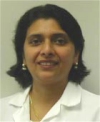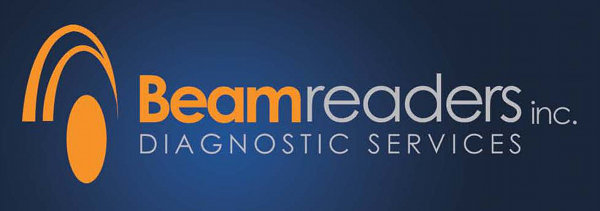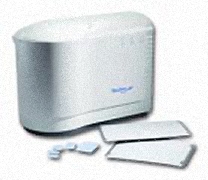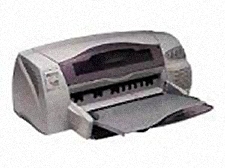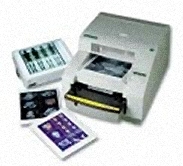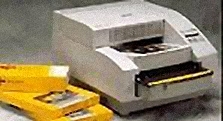|
Printers and Print media: The general purpose ink jet printers are relatively cheap and easy to use, hence the HP DeskJet 1220C printer (Hewlett-Packard Company, CA) was selected as one modality to print dental digital images.
Another printer used was a Codonics NP 1660M Series Printer (Codonics, Inc. Middleburg Heights, OH) which represented the higher end of the cost spectrum and also represents dye-diffusion printing technology which is hailed as a superior technology when compared to ink-jet printing. 8.5 X 11 in. Kodak Distributed Medical Imaging Paper (Eastman Kodak Company, Rochester, NY) was used to print digital images. On subjective evaluation, the quality of printouts obtained on Kodak DMI paper were far more superior than other brand name glossy Photo papers available in the stores, hence it was decided to use Kodak paper. Chroma VistaTM Paper (8.5 X 10 in) and Direct VistaTM Film (8 x 10 in) (both recommended for the Codonics printer) were used for printing hard copies with the Codonics NP 1660M Series Printer Codonics NP 1660M Series Printer (Codonics, Inc.) Before the introduction of digital imaging systems, film mounted on a lighted view box was the most common method of diagnosing caries. Dentists are more used to looking at the films through transmitted light. Hence it was decided to print images on both transparent film as well as glossy paper. In order to obtain adequate print quality, subjective evaluation of the printouts was performed. Once a consensus was reached, those particular settings were selected on the printers to obtain hard copies of the test images. Print size: Printout size is an important issue. It not only affects the diagnostic capability but also the cost and time involved in printing the images. For example you can choose to print a 18- 20 images FMX on one sheet or you can choose to print one periapical size image on each sheet of paper.Print size is determined by the image system's display software, printer settings and print medium. A pilot study was conducted to determine a suitable print size for printing the images. Results of the pilot study showed that the bitewing (1.5x-magnified) format was significantly better than the Full mouth (unmagnified) format for proximal caries detection in printed images. The purpose of this study was to assess the performance of various print technologies in relation to digital images for proximal caries detection. The results of the study showed that the print outs were comparable to digital images in their diagnostic performance. A trend in improved caries detection performance was seen with Codonics printed hard copies when compared to the hard copies printed on inkjet printer. The Codonics printer prints on special paper with dye diffusion technology, which is considered a superior technology and is relatively expensive compared to the inkjet printing as provided HP printer. Because the results of our study showed no statistically significant difference in the diagnostic performance of the paper hard copies obtained from the two printers, its reasonable to say that for caries detection ink jet printers are up to the task. |
Any new modality should fulfill at least the following three criteria: First, it should provide diagnostic information superior to or at least equal to the current system; second, it should be cost effective; and third it should be easy to operate. Hard copies obtained from the printers seemed to fulfill all these criteria. The initial cost involved with dye sublimation printer is high as compared to ink jet printers, but the cost of printed paper copy is less than $1 with the printers.
The hard copy printouts available currently have sufficient quality, even for diagnostic purposes. However, if digitization is to be meaningful and its potential fully exploited, the evaluation work should be based on monitor systems instead of hard copies. Paper might seem to be an inferior redundancy to film. But in fact, paper offers an economical and flexible medium that allows images to be used for tasks that previously have not included image display, such as patient report generation, student and employee instruction, and record keeping in research.
Our results suggest that caries diagnosing efficacy of hard copies was comparable to images displayed on CRT monitor. The option of hard copy certainly warrants exploration with other diagnostic tasks in dental radiography. This is especially true during periods of transition from analog to completely digital/electronic environments.
The hard copy printouts available currently have sufficient quality, even for diagnostic purposes. However, if digitization is to be meaningful and its potential fully exploited, the evaluation work should be based on monitor systems instead of hard copies. Paper might seem to be an inferior redundancy to film. But in fact, paper offers an economical and flexible medium that allows images to be used for tasks that previously have not included image display, such as patient report generation, student and employee instruction, and record keeping in research.
Our results suggest that caries diagnosing efficacy of hard copies was comparable to images displayed on CRT monitor. The option of hard copy certainly warrants exploration with other diagnostic tasks in dental radiography. This is especially true during periods of transition from analog to completely digital/electronic environments.

